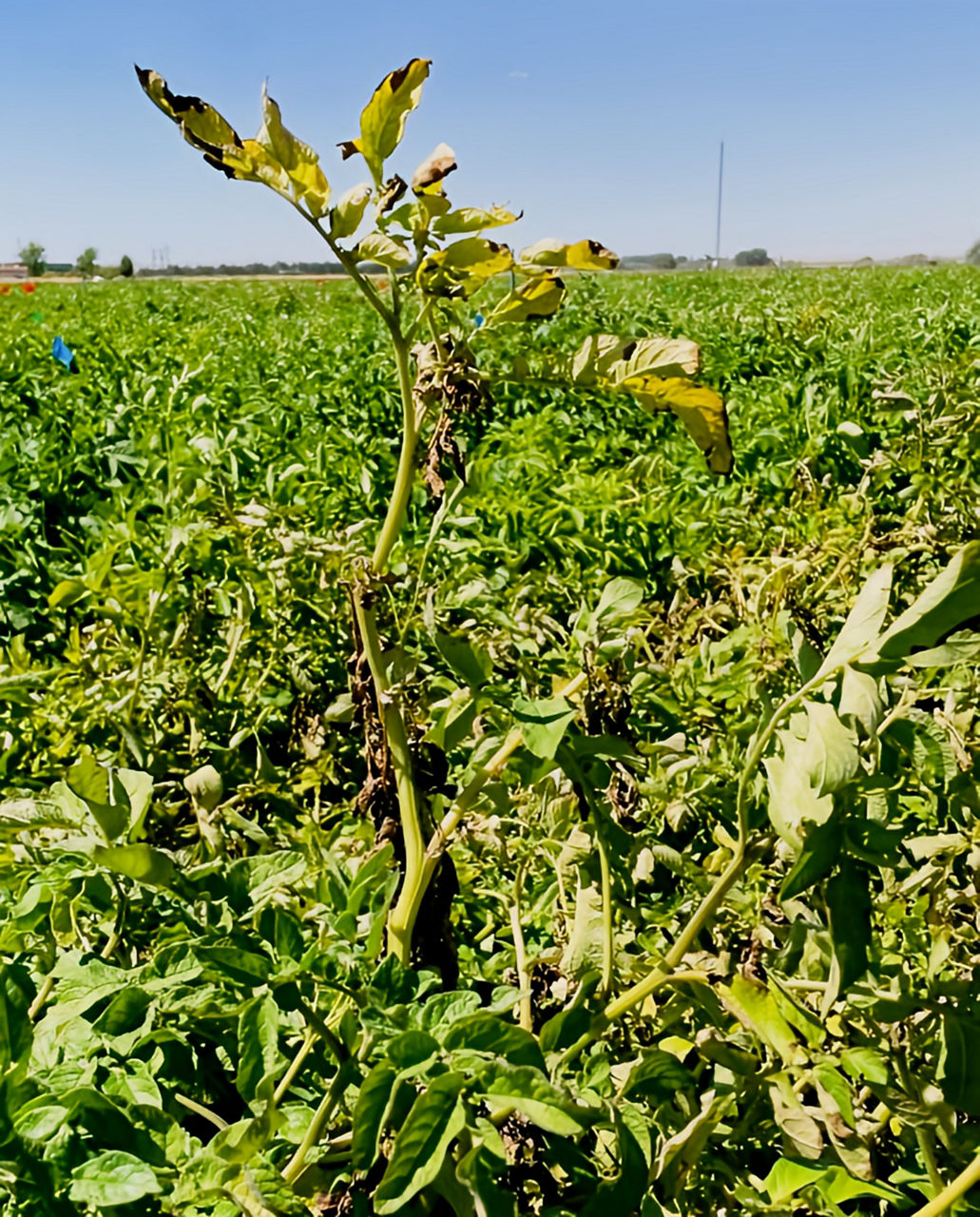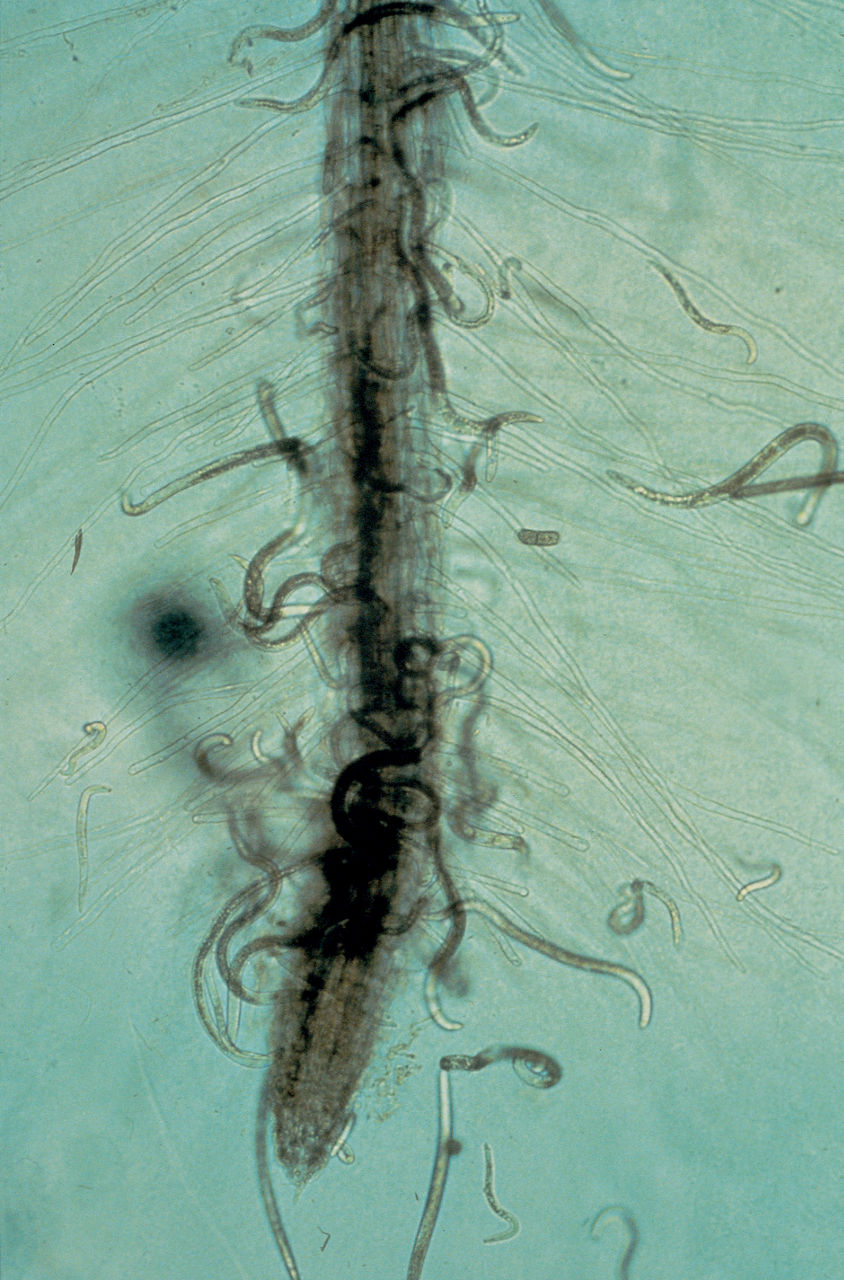Managing Nematodes and the Potato Early Dying Complex
December 11, 2024
At first appearance, the potato early dying complex (PED) is seemingly inexplicable. The plants were thriving and then they were dying. At that point, a grower has no options. The PED disease complex is made up of the soilborne fungus Verticillium dahliae, the primary causal agent which infects potato roots and also causes Verticillium wilt, and the root lesion nematode (Pratylenchus penetrans). Other diseases also are thought to contribute to the PED complex such as early blight, black dot, and Botrytis blight. Yield losses of 50% may occur with severe infection with reductions in marketable yield and tuber quality. The combination of Verticillium wilt and PED is arguably the most economically damaging problem facing the US potato industry, due to the losses from the disease itself and the costs associated with its management.
The root lesion nematode and the synergistic interaction with Verticillium wilt are thought to drive PED; however, there are several species of nematodes that can have a negative impact on the yield potential and/or quality of a potato crop (Figure 1). Not all nematode species are present in all potato growing regions. The nematodes with the most economic impact on potatoes are the root lesion nematodes. Although there are two species of root lesion nematodes, Pratylenchus neglectus and P. penetrans, only P. penetrans has been shown to be involved in PED. While the exact mechanism that causes the interaction of root lesion nematodes and Verticillium wilt to develop into PED is unknown, two hypotheses are generally accepted as possibilities. The first hypothesis is that root lesion nematodes create wounds on potato roots, allowing entry by Verticillium dahliae and other pathogens. The other hypothesis is that root lesion nematodes change the physiology of the potato plant, rendering the plant more susceptible to the disease. Regardless of which interaction occurs, it takes very few P. penetrans nematodes to make Verticillium wilt a much more serious problem. If you have fields with this nematode, control measures should be considered and implemented.
Other nematode species also may contribute to the early death of potato plants, even if they are not directly associated with PED. For example, root knot nematodes (Meloidogyne spp.) are problematic in certain potato regions and have more of an impact on tuber quality than on yield reduction. Additionally, potato cyst nematodes (Globodera spp.) are quarantinable pests in the US. Strict quarantines have confined the golden cyst nematode (G. rostochiensis) to a limited area in the state of New York and the pale cyst nematode (G. pallida) to small areas in Idaho. Lastly, stubby-root nematodes (Trichodorus and Paratrichodorus) are also problematic in certain potato-producing regions of the US. Stubby-root nematodes also vector the tobacco rattle virus (TRV), the causal agent of corky ringspot (also called “spraing”) which makes potato tubers non-marketable.
Once Verticillium wilt is established in a field and root lesion nematodes (P. penetrans) are confirmed to be present, control measures should be implemented early in the season to optimize tuber yield and quality at harvest. Several management tools can be used, including planting potato varieties more resistant to Verticillium, stretching crop rotations so that potatoes are grown less frequently on that field, incorporating green manures and/or biofumigants, and the susing soil fumigants. Incorporating these strategies in an integrated approach for managing PED will help reduce both nematode and Verticillium populations.
With a cost of $300+/acre, the use of soil fumigants such as metam sodium to manage Verticillium wilt and nematode species can have a substantial financial impact on the grower. Additionally, sustainability efforts by major wholesale and retail French fry distributors more closely scrutinize the use of soil fumigants. Metam sodium has recently gone through re-registration with the EPA, with numerous restrictions placed on its use to reduce exposure to volatiles released during soil treatments. Fortunately, Bayer offers non-fumigant solutions to help with the management of the root-lesion nematode and Verticillium wilt components of the PED complex.
The Use of Velum® Fungicides and Nematicides and Movento® Insecticide for PED
Velum® Rise fungicide and nematicide and Velum® Prime fungicide and nematicide applied in-furrow for season-long suppression of Rhizoctonia, black dot, and nematodes provides a foundation for a strong harvest. As mentioned above, one strategy for managing PED is the use of soil fumigants, which act as general biocides in the soil. Velum® Rise and Velum® Prime target nematodes and fungal pathogens, and in-furrow applications allow for early protection that will last through the season to help maximize yield potential. Velum® Prime can be applied as a foliar spray after emergence or as an in-furrow treatment, while Velum® Rise is applied as an in-furrow treatment.
The Payoff with Velum® Rise and Velum® Prime and the Velum + Movento Solution
Bayer field trials have demonstrated the value of using Velum® Rise and Velum® Rise Prime, in addition to standard grower practices, to help manage PED and increase tuber yields potential. The “V+M Solution” (Table 1) is a coordinated use of Velum® Rise, Velum® Prime, and Movento® HL insecticide to help suppress both the fungal and nematode components of PED. Both Velum® Rise and Velum® Prime are labeled for the suppression of nematodes and Verticillium wilt, and Movento® HL is labeled for the suppression of nematodes. In one 2023 third-party study, yield levels (cwt/acre) in plots treated using the V+M solution protocol showed marketable yields of 642 cwt/acre compared to 526 cwt/acre for the nontreated plots, which was a significant difference based on a Fisher’s LSD analysis (α=0.01).
The goal of the V+M solution protocol is to help provide effective nematode and Verticillium wilt management in order to help protect plants from PED resulting in increased yield potential and tuber quality.
Table 1. The V + M Solution



BAYER GROUP DOES NOT WARRANT THE ACCURACY OF ANY INFORMATION OR TECHNICAL ADVICE PROVIDED HEREIN AND DISCLAIMS ALL LIABILITY FOR ANY CLAIM INVOLVING SUCH INFORMATION OR ADVICE.
ALWAYS READ AND FOLLOW PESTICIDE LABEL DIRECTIONS.
Not all products are registered for use in all states and may be subject to use restrictions. The distribution, sale, or use of an unregistered pesticide is a violation of federal and/or state law and is strictly prohibited. Check with your local dealer or representative for the product registration status in your state. Bayer, Bayer Cross, Movento® HL, and Velum® are registered trademarks of Bayer Group. For additional product information call toll-free 1-866-99-BAYER (1-866-992-2937) or visit our website at www.BayerCropScience.us. Bayer CropScience LP, 800 North Lindbergh Boulevard, St. Louis, MO 63167. ©2024 Bayer Group. All rights reserved.
7211_450350